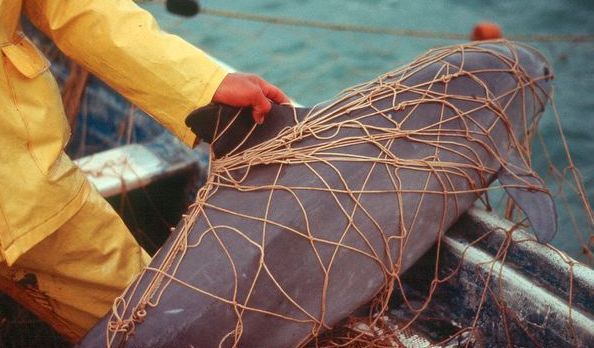Scientific Societies Ask Mexico to Take Additional Steps to Save the Vaquita, the World’s Smallest and Most Endangered Porpoise
 December 18, 2012. Since its discovery fifty years ago, the vaquita (Phocoena sinus), or Gulf of California harbor porpoise, has been recognized as one of the rarest and most endangered marine mammals in the world. The vaquita, which is Spanish for “little cow”, is especially vulnerable to drowning in gillnet fishing nets, and today there are less than 200 individuals remaining in the world. Scientists estimate that the vaquita population is declining at nearly 8% per year. Unless more is done to restrict gill-net fishing in the northern Gulf of California, the vaquita will likely follow the baiji (Lipotes vexillifer), or China’s Yangtze River Dolphin, into extinction.
December 18, 2012. Since its discovery fifty years ago, the vaquita (Phocoena sinus), or Gulf of California harbor porpoise, has been recognized as one of the rarest and most endangered marine mammals in the world. The vaquita, which is Spanish for “little cow”, is especially vulnerable to drowning in gillnet fishing nets, and today there are less than 200 individuals remaining in the world. Scientists estimate that the vaquita population is declining at nearly 8% per year. Unless more is done to restrict gill-net fishing in the northern Gulf of California, the vaquita will likely follow the baiji (Lipotes vexillifer), or China’s Yangtze River Dolphin, into extinction.
Because of the urgency of addressing this conservation challenge, the Society of Marine Mammalogists, the European Cetacean Society, and the Society for Conservation Biology have sent a letter to Enrique Pena Nieto, the newly-elected President of Mexico, and to his administration, to take additional steps to phase out gill-net fishing in the northern Gulf of California.
Fortunately, there is cause for optimism regarding the conservation of the vaquita. Mexico’s National Institute of Fisheries (INAPESCA) has successfully tested alternative fishing gear that allows for the harvest of blue shrimp in the Gulf of California, while substantially reducing the risks of vaquitas accidentally drowning in fishing nets. Phasing out gill-nets and transitioning to these alternative fishing techniques will allow local fishermen to continue pursuing their livelihoods while saving the lives of many vaquitas.
The International Committee for the Recovery of the Vaquita has met four times to discuss the species’ situation, concluding that a gillnet ban continues to be the single-most, highest priority conservation action that can be undertaken to save the vaquita. The Mexican Government has begun to phase out gillnets through a series of buy-outs and gear swapping initiatives.
Read the joint letter to the President of Mexico HERE and its English translation HERE.
Read the report of the International Committee for the Recovery of the Vaquita HERE.
Read a factsheet about the Vaquita-safe fishing gear HERE.
To learn more about the vaquita, visit the IUCN’s Cetacean Specialist Group website. To learn about more how you can help the vaquita, go to ¡Viva Vaquita!